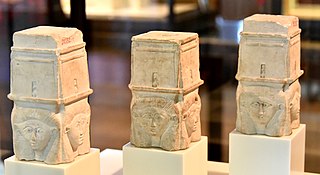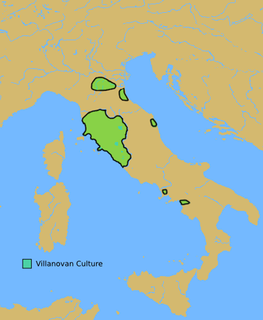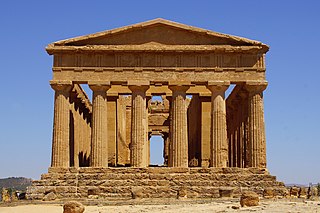
Empúries was an ancient city on the Mediterranean coast of Catalonia, Spain. Empúries is also known by its Spanish name, Ampurias. The city Ἐμπόριον was founded in 575 BC by Greek colonists from Phocaea. After the invasion of Gaul from Iberia by Hannibal the Carthaginian general in 218 BC, the city was occupied by the Romans. In the Early Middle Ages, the city's exposed coastal position left it open to marauders and it was abandoned.

Tarquinia, formerly Corneto, is an old city in the province of Viterbo, Lazio, Central Italy, known chiefly for its ancient Etruscan tombs in the widespread necropoleis, or cemeteries, for which it was awarded UNESCO World Heritage status.
Clusium was an ancient city in Italy, one of several found at the site. The current municipality of Chiusi (Tuscany) partly overlaps this Roman walled city. The Roman city remodeled an earlier Etruscan city, Clevsin, found in the territory of a prehistoric culture, possibly also Etruscan or proto-Etruscan. The site is located in northern central Italy on the west side of the Apennines.

Cerveteri is a town and comune of northern Lazio in the region of the Metropolitan City of Rome. Known by the ancient Romans as Caere, and previously by the Etruscans as Caisra or Cisra, and as Agylla by the Greeks, its modern name derives from Caere Vetus used in the 13th century to distinguish it from Caere Novum.

Tuna el-Gebel was the necropolis of Khmun. It is the largest known Greco-Roman necropolis in Egypt, dating from the New Kingdom to the Roman Period, and seeing heavy use in the Ptolemaic Period. Tuna el-Gebel is located in Al Minya Governorate in Middle Egypt.

The Villanovan culture, regarded as the earliest phase of the Etruscan civilization, was the earliest Iron Age culture of Italy. It directly followed the Bronze Age Proto-Villanovan culture which branched off from the Urnfield culture of Central Europe. The name derives from the locality of Villanova, a fraction of the municipality of Castenaso in the Metropolitan City of Bologna where, between 1853 and 1855, Giovanni Gozzadini found the remains of a necropolis, bringing to light 193 tombs, of which there were 179 cremations and 14 inhumations.

Caere is the Latin name given by the Romans to one of the larger cities of southern Etruria, the modern Cerveteri, approximately 50–60 kilometres north-northwest of Rome. To the Etruscans it was known as Cisra, to the Greeks as Agylla and to the Phoenicians as Kyšryʼ.

The Valley of the Kings, also known as the Valley of the Gates of the Kings, is a valley in Egypt where, for a period of nearly 500 years from the 16th to 11th century BC, rock-cut tombs were excavated for the pharaohs and powerful nobles of the New Kingdom.

The Necropolis of Pantalica is a collection of cemeteries with rock-cut chamber tombs in southeast Sicily, Italy. Dating from the 13th to the 7th centuries BC, there was thought to be over 5,000 tombs, although the most recent estimate suggests a figure of just under 4,000. They extend around the flanks of a large promontory located at the junction of the Anapo river with its tributary, the Calcinara, about 23 km (14 mi) northwest of Syracuse. Together with the city of Syracuse, Pantalica was listed as a UNESCO World Heritage Site in 2005.

Ameno is a comune (municipality) in the Province of Novara in the Italian region of Piedmont, located about 100 kilometres (62 mi) northeast of Turin and about 40 kilometres (25 mi) northwest of Novara. As of 31 December 2004, it has a population of 906 and an area of 10.0 square kilometres (3.9 sq mi).

The Valle dei Templi, or Valley of the Temples, is an archaeological site in Agrigento, Sicily. It is one of the most outstanding examples of Magna Graecia art and architecture, and is one of the main attractions of Sicily as listed in 1997. Much of the excavation and restoration of the temples was due to the efforts of archaeologist Domenico Antonio Lo Faso Pietrasanta (1783–1863), who was the Duke of Serradifalco from 1809 through 1812. During the 20th century, the archeological excavation was mainly funded by Captain Alexander Hardcastle. He permitted excavations within the archaeological park including the straightening of the eight columns on the south side of the Temple of Heracles. For his contributions to archaeology he was made an honorary citizen of the city of Agrigento and was granted in 1928 the rank of Commander of the Order of the Crown of Italy.

The hill of Sant'Ippolito, known by the name of “Colle del Bersaglio”, is a hill located in the Italian town of Caltagirone, in Sicily. It is made of gypsum, it is about 400 m high, and rises from the valley that is formed by the course of the river Caltagirone.

The Gaudo Culture is an Eneolithic culture from Southern Italy, primarily in the region of Campania, active at the end of the 4th millennium BC, whose typesite necropolis is located near Paestum, not far from the mouth of the river Sele. Its name comes from the Spina-Gaudo necropolis.

Kition was a city-kingdom on the southern coast of Cyprus. According to the text on the plaque closest to the excavation pit of the Kathari site, it was established in the 13th century BC by Greek (Achaean) settlers, after the Trojan war.

The Hypogeum of the Volumnus family is an Etruscan tomb in Ponte San Giovanni, a suburb of Perugia, Umbria, central Italy. Its dating is uncertain, although it is generally assigned to the 3rd century BC.

The Monterozzi necropolis is an Etruscan necropolis on a hill east of Tarquinia in Lazio, Italy. The necropolis has about 6,000 graves, the oldest of which dates to the 7th century BC. About 200 of the tomb chambers are decorated with frescos.

The Tomb of Hunting and Fishing, formerly known as the Tomb of the Hunter, is an Etruscan tomb in the Necropolis of Monterozzi near Tarquinia, Lazio, Italy. It was discovered in 1873 and has been dated variously to about 530–520 BC, 520 BC, 510 BC or 510–500 BC. Stephan Steingräber calls it "unquestionably one of the most beautiful and original of the Tarquinian tombs from the Late Archaic period." R. Ross Holloway emphasizes the reduction of humans to small figures in a large natural environment. There were no precedents for this in Ancient Greek art or in the Etruscan art it influenced. It was a major development in the history of ancient painting.

The Tomb of the Triclinium ) is an Etruscan tomb in the Necropolis of Monterozzi dated to approximately 470 BC. The tomb is named after the Roman triclinium, a type of formal dining room, which appears in the frescoes of the tomb. It has been described as one of the most famous of all Etruscan tombs.

Etruscan architecture was created between about 900 BC and 27 BC, when the expanding civilization of ancient Rome finally absorbed Etruscan civilization. The Etruscans were considerable builders in stone, wood and other materials of temples, houses, tombs and city walls, as well as bridges and roads. The only structures remaining in quantity in anything like their original condition are tombs and walls, but through archaeology and other sources we have a good deal of information on what once existed.
There are some Macedonian tombs and the necropolises of Pydna around ancient Pydna and beside the ancient road from Methone in the north to Dion in the south. The oldest tombs are from the Bronze Age; the youngest are from the early Christian period. Smaller tumuli have eroded over time and are no longer visible. Most excavations have had to be carried out to save the sites. The finds in both areas show a shrinking population during the second Greek colonization.

















